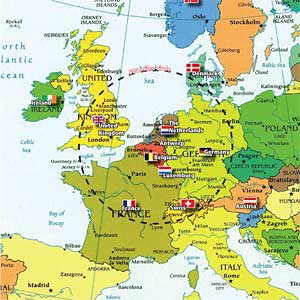This page is growing almost daily.
Setting Sail – From Belgium to North America
by Willy Mertens
I have subscribed to The Draft Horse Journal since the 1980s. As both the president of a non-profit organization whose goal is to keep the draft horse working, and the local publisher of a tiny, Flemish monthly magazine called Het Werkend Trekpaard ("The Working Draft Horse"), I was always thrilled whenever a new issue arrived here in Belgium. I'm always impressed with the articles I read in this wonderful magazine.
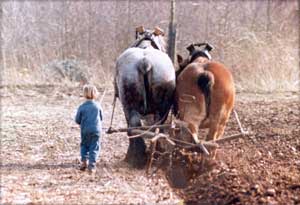
I sent a picture of my son ploughing with a team on a jerk line to Maurice Telleen and he printed it in the Autumn 1994 Journal (page 178). After seeing it in the magazine, Butch Lepley, a horse puller from Meyersdale, Pennsylvania, called us and invited us to visit his farm. That next summer, we booked tickets from Brussels to New York, rented a car and drove non-stop to his place in southwest Pennsylvania.
We were very impressed by the size of Butch's pullers. We visited other local horse owners and, as a matter of fact, ALL of the work horses were BIG. Most of the Amish in the Meyersdale area knew Butch as he had a sawmill business. Prior to this, we have never met Amish farmers before. We visited a lot of farms and were continually impressed by the number of work horses these farmers had and were using on the land every day. This was unknown in Europe! As was the fact that they were using modern machinery!
Realizing our intense fascination in horse-drawn machinery, Butch suggested that we head to the 2nd annual Horse Progress Days being held in northern Indiana. On the way, we stopped at Orndorff's Belgian Farm in Waynesburg, Pennsylvania, where we enjoyed a private tour by Christina Lemley.
Once we arrived at Horse Progress Days, it was like a dream in the daylight! We enjoyed every minute of every demonstration. And since then, we have attended several more Horse Progress Days. We even helped the American Brabant Association set up their first booth at Kinzers, Pennsylvania (by supplying them with pictures of our Brabant Belgians).
It wasn't long before our visits to the States were reciprocated. In 2000 and 2002 a few Americans came to Belgium to buy Brabant foals. We ended up exporting a total of 12 horses, via two shipments. Then, in the autumn of 2007, Tommy Flowers of Blackville, South Carolina, visited Belgium and bought a Brabant colt to replace his famous stallion Rocky.
It should come as no surprise that transporting horses by air is a very expensive proposition. A one-way ticket for one horse from Amsterdam to New York costs about $5,000 US! Of course, this is prohibitive for many breeders. We assumed that more people would be interested in bringing over a Brabant (or any breed of work horse) if the price was more affordable, so we started looking around to find a cheaper way to ship them.
Last summer, we were fortunate enough to meet a man involved in livestock transport by ocean vessel. Though he usually works in South America and/or Australia, he told us his ships could be chartered anywhere in the world. Then the Winter 2009-'10 DHJ arrived and we devoured the lead story on the Seagoing Cowboys. The idea for a once-in-a-lifetime opportunity was born!
The concept is this: We will charter a livestock carrier ship and offer interested North Americans the opportunity of bringing home their dream horse at a much more reasonable price than air transport offers. Taking it one step further, the ship will have to come back to Europe, so why not invite Europeans to tour U.S. and Canadian horse farms with the knowledge that they can get their North American purchases transported back home at a great rate?
We had several questions and lots of details to work out, but after hundreds of phone calls, E-mails and personal visits, we are confident that we finally know everything about the required paperwork, permits, blood tests, quarantine rules and harbor regulations on both sides of the Atlantic!
Our plan, then, is to charter a livestock carrier able to stall 350 horses. The cost to get one horse to North America will be just $2,000! We will organize the ground transportation, the lab work, the paperwork, the quarantine–basically the whole ball of wax, from the farm in Europe up to the quarantine facility in Canada. The transportation from this quarantine facility to the buyer's farm can also be arranged if the buyer wishes.
Antwerp, Belgium, and Charlottetown, PEI, Canada are the most convenient harbors for this endeavor. Antwerp is located in the geographical middle of the work horse breeds in Europe. Any work horse studbook you can imagine is situated less than 500 miles from Antwerp. Charlottetown is the capital of Prince Edward Island and serves as the gateway to the rest of the continent.
Quarantine regulations and quarantine costs for entering Canada are the cheapest and easiest for geldings and for animals of less than two years of age.
Geldings & horses under 2 years of age: $115 CDN + 13% tax + 3 days quarantine ($30 CDN)
Mares over 2 years of age: $440 CDN + 13% tax + 14 days quarantine ($140 CDN)
Stallions over 2 years of age: $1,125 CDN+ 13% tax + 30 days quarantine ($300 CDN)
Our goal is to schedule this trip in April of 2011. If we can convince enough North-Americans to pay for a cheap "horse ticket" to fill the boat going one way, and enough Europeans to do likewise heading back, we will have succeeded.
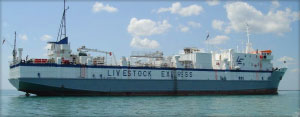
Interested in visiting Buffalo Express, the chartered livestock vessel before the workhorse trip?
USA, Wilmington, Delaware:
- June 18/19, 2010
- August 03/04, 2010
- September 19/20, 2010
Antwerp (Belgium)
Additionel costs before the horses can board the vessel:
Bloodtest:
- Veterinary costs to come to the farm: € 34,00
- Veterinary costs to draw blood: € 12,00
- Veterinary costs for cemsample: € 12,00
- Paperwork done by veterinary: € 12,00
- Total: € 70,00
These vet costs might be almost € 0,00 if the veterinary students of the University in Gent (Belgium) assist at this project.
Laboratory costs at Boese (www.labor-boese.de)
For exportation of horses (<2 years) to the U.S. and Canada, the following analysis are necessary:
- Piroplasmosis (includes testing for Babesia equi and Babesia caballi by test methods C-ELISA and IFAT): € 100,00
- Equine Infectious Anemia (Coggins Test): € 18,00
- Dourine (CFT): € 18,00
- Glanders (CFT): € 18,00
- Total: € 154,00
For exportation of horses (>2 years) to the U.S. and Canada cem test is necessary:
- Cem: € 30,00
- Total: € 30,00
Healthcertificates for crossing intra-European Borders: € 70,00/truck to board in Antwerp.
Charlottetown
(Prince Edward Island, Canada)
Additional costs after landing in Charlottetown:
Inspection of horses at first port of entry: CAD $30,00 + 13% tax / horse
Testing of horses while in quarantaine:
- Geldings & horses under 2 years of age: $115 CAD + 13% tax + 3 days quarantine ($30 CAD) + vet costs
- Mares over 2 years of age: $440 CAD + 13% tax + 14 days quarantine ($140 CAD) + vet costs
- Stallions over 2 years of age: $1,125 CAD + 13% tax + 30 days quarantine ($300 CAD) + breed two local mares + vet costs
These vet cost might be almost € 0,00 if the veterinary students of the University in Charlottetown (Prince Edward Island) assist at this project.
Contact me
Please have a look at the current time in Belgium first. Thank you.
Did you know the Brabant Belgian has seven colors?
Bai, Bai Roan, Black, Blue, Sorrel, Sorrel Roan, Applegrey
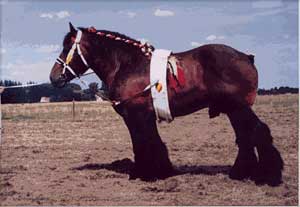
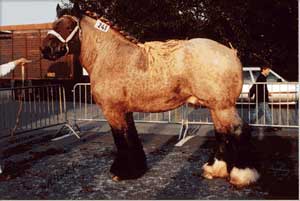
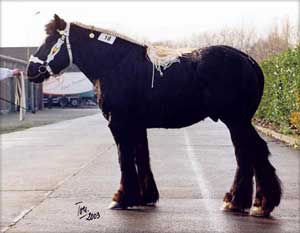
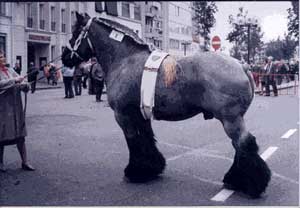
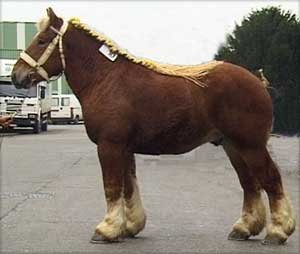
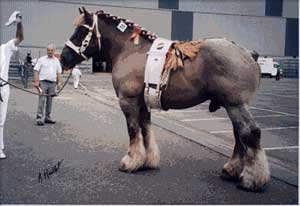
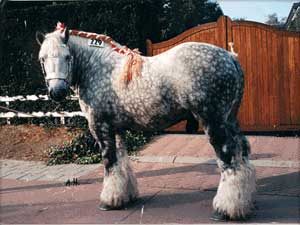
Workhorse Studbooks in Western Europe
Belgium
-
www.kmbt-srctb.be
www.horseweb.be - www.vlaamspaard.be
- www.chevaldetraitardennais.be
- www.arabofriesiansporthorses.net
The Netherlands
Luxemburg
France
- Magazine: Sabots f.durand@diligence-presse.com
- www.france-trait.fr
- www.chevalcomtois.com
- www.traitauxois.com
- www.percheron-france.org
- www.cheval-breton.fr
- www.cheval-ardennais.fr
- www.cobnormand.com
- www.traitpoitevin.com
United Kingdom
- Magazine: Heavy Horse World www.heavyhorseworld.co.uk
- www.shire-horse.org.uk
- www.clydesdalehorsesociety.com
- www.suffolkhorsesociety.org.uk/the-suffolk-stud-book
Ireland
Germany
- Magazine: Starke Pferde www.starke-pferde.de
- www.pzv-bw.de
- www.bayerns-pferde.de
- www.brandenburger-pferd.de
- www.ponyverband.de
- www.mecklenburger-pferde.de
- www.kaltblutpferde-nds.de
- www.pferdezucht-rheinland.de
- www.pferdezucht-rps.de
- www.pferdestammbuch-sh.de
- www.westfalenpferde.de
- www.schleswiger-kaltblut.de
- www.schwarzwaelder-kaltblut.de
